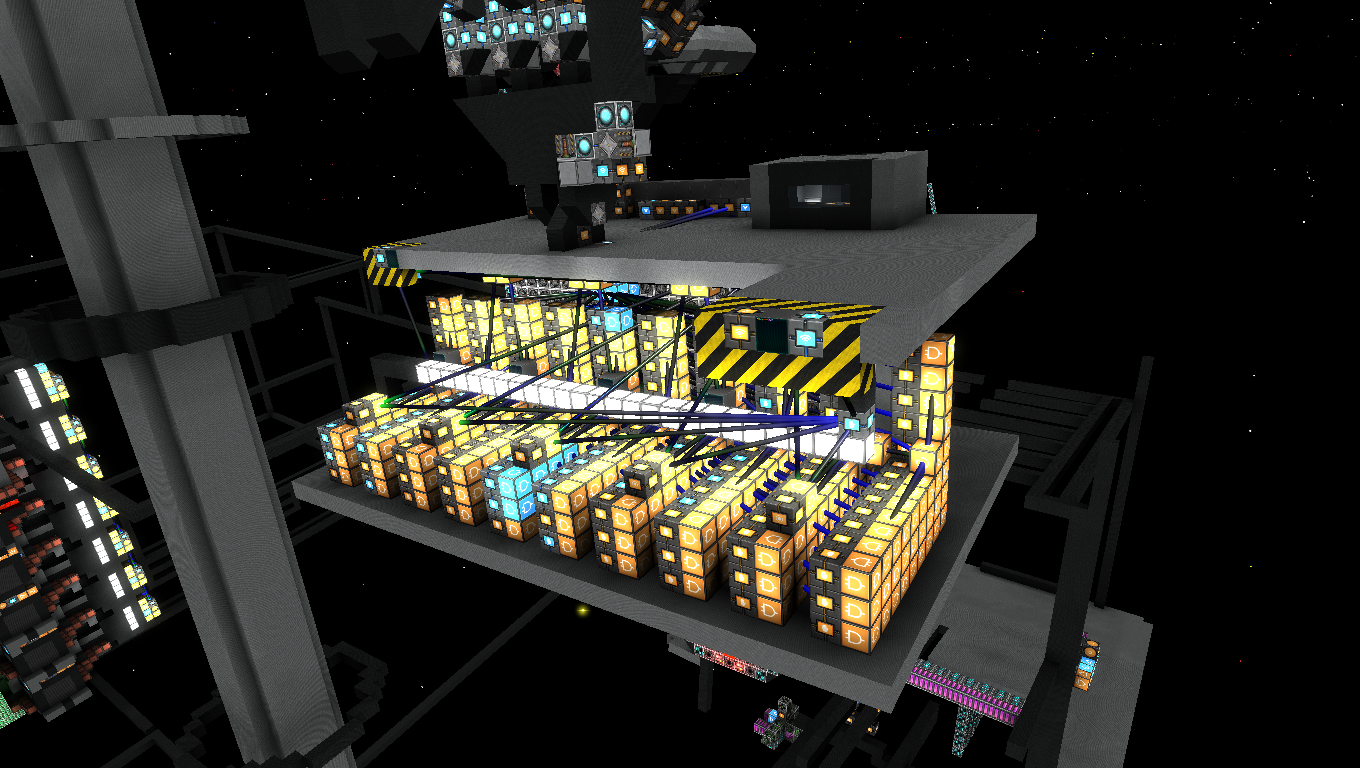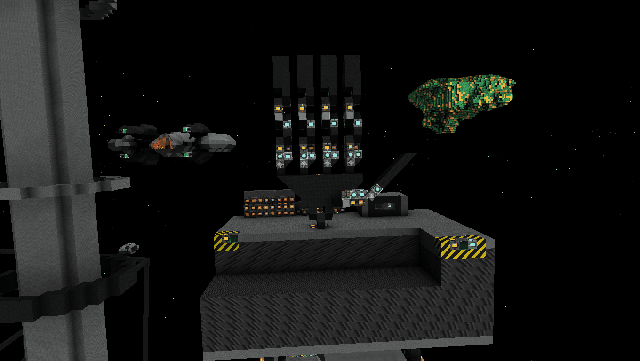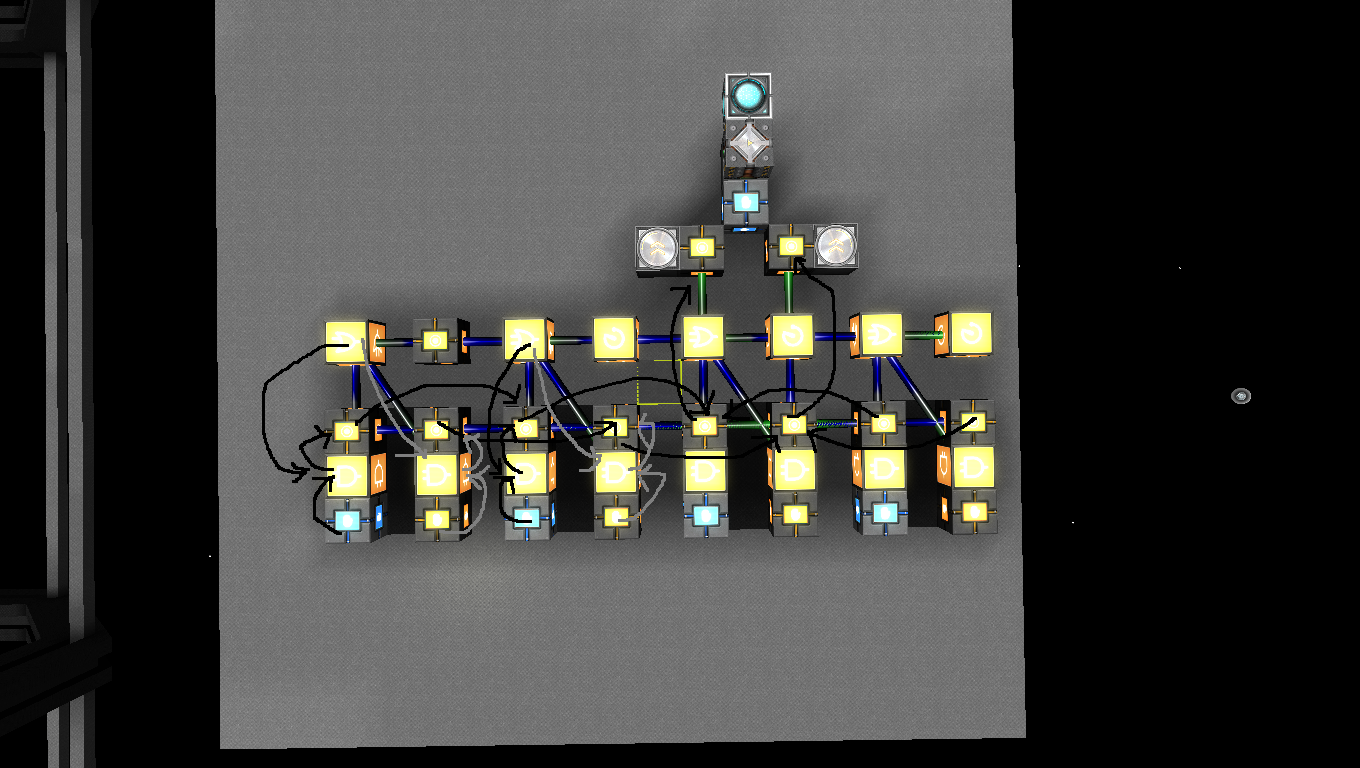My Mech Build
- Thread starter Lone_Puppy
- Start date
CyberTao
鬼佬
It's a good start! I'd recommend reworking the joint at the base of the thumb though, the motions seem just a bit off. You got the basics of the mech logic down though, full control twitch based logic is good for finer control over things like fingers, but you may want to try and incorporate some 2-state motions later on to save some wireless connections, would make animating a bit easier as well once you get further into it.
Good luck on the endeavor though, and be mindful of the size! Mass enhancers can be a right pain with limited space.
Good luck on the endeavor though, and be mindful of the size! Mass enhancers can be a right pain with limited space.
Yeah the thumb was difficult to work out.It's a good start! I'd recommend reworking the joint at the base of the thumb though, the motions seem just a bit off. You got the basics of the mech logic down though, full control twitch based logic is good for finer control over things like fingers, but you may want to try and incorporate some 2-state motions later on to save some wireless connections, would make animating a bit easier as well once you get further into it.
Good luck on the endeavor though, and be mindful of the size! Mass enhancers can be a right pain with limited space.
It's a work in progress, so I'm not too worried at this stage.
I'm planning on pre configured actions and have already begun planning the wireless logic.
The mass does worry me, but i will see how it goes.
Thanks for the helpful advice.
"Its like old school punchcards." Like that. You are mechanically encoding the movements of the hand, far from what I expected. You could easily encode very complex gestures, but ultimately, it will take up a lot of space. Thankfully, you have plenty of space assuming your mech doesn't move. However, I worked on robotic hands since the beginning of the rails update, and early on used digital logic. Currently my hand is 2.0, and perhaps too complex for your needs, but the 1.0 had simpler logic, so I'll show you the circuit and explain how I made it:

Just focus on the cell to the far right. All I used were activators, hooked into ANDs, which also have a button hooked into it, so that when the circuit receives a pulse, it would output the bits that are activated to the hand. You seem to know how many bits it would take to control your hand; about two for each joint, three if you want to control whether it moves 45 or 90 degrees. Sum all of these up, and just make a memory cell that hold all of these bits. You can just use activators hooked into ANDs, assuming you want to define a fixed set of motions. Tip: you can slave activators to the ANDs; it will allow you to bus the output through the outputs of the other memory cells, saving time. Output this to the activators controlling the hand. This is the first 'frame.' For example entering a pose from a neutral state.
Make another memory cell, exactly the same as the other, hooked up the same way(except you might bus the output through the first cell, instead of directly). This one can be used to tell the hand how to properly exit a pose, return to normal. The second 'frame.' Repeat for each frame you will need, in case you want more complicated gesturing.
After that, you just have to make a chain of delays, hooked up to the buttons activating the memory cells, and you can set the hand up to perform gestures by setting the activators.
The result(if I was clear enough) should be movement:

(Programmed to do Rocks Paper Scissors)
If you need me to explain a little further, just let me know.
EDIT: Added spoiler

Just focus on the cell to the far right. All I used were activators, hooked into ANDs, which also have a button hooked into it, so that when the circuit receives a pulse, it would output the bits that are activated to the hand. You seem to know how many bits it would take to control your hand; about two for each joint, three if you want to control whether it moves 45 or 90 degrees. Sum all of these up, and just make a memory cell that hold all of these bits. You can just use activators hooked into ANDs, assuming you want to define a fixed set of motions. Tip: you can slave activators to the ANDs; it will allow you to bus the output through the outputs of the other memory cells, saving time. Output this to the activators controlling the hand. This is the first 'frame.' For example entering a pose from a neutral state.
Make another memory cell, exactly the same as the other, hooked up the same way(except you might bus the output through the first cell, instead of directly). This one can be used to tell the hand how to properly exit a pose, return to normal. The second 'frame.' Repeat for each frame you will need, in case you want more complicated gesturing.
After that, you just have to make a chain of delays, hooked up to the buttons activating the memory cells, and you can set the hand up to perform gestures by setting the activators.
The result(if I was clear enough) should be movement:

(Programmed to do Rocks Paper Scissors)
If you need me to explain a little further, just let me know.
EDIT: Added spoiler
Coolies!"Its like old school punchcards." Like that. You are mechanically encoding the movements of the hand, far from what I expected. You could easily encode very complex gestures, but ultimately, it will take up a lot of space. Thankfully, you have plenty of space assuming your mech doesn't move. However, I worked on robotic hands since the beginning of the rails update, and early on used digital logic. Currently my hand is 2.0, and perhaps too complex for your needs, but the 1.0 had simpler logic, so I'll show you the circuit and explain how I made it:

Just focus on the cell to the far right. All I used were activators, hooked into ANDs, which also have a button hooked into it, so that when the circuit receives a pulse, it would output the bits that are activated to the hand. You seem to know how many bits it would take to control your hand; about two for each joint, three if you want to control whether it moves 45 or 90 degrees. Sum all of these up, and just make a memory cell that hold all of these bits. You can just use activators hooked into ANDs, assuming you want to define a fixed set of motions. Tip: you can slave activators to the ANDs; it will allow you to bus the output through the outputs of the other memory cells, saving time. Output this to the activators controlling the hand. This is the first 'frame.' For example entering a pose from a neutral state.
Make another memory cell, exactly the same as the other, hooked up the same way(except you might bus the output through the first cell, instead of directly). This one can be used to tell the hand how to properly exit a pose, return to normal. The second 'frame.' Repeat for each frame you will need, in case you want more complicated gesturing.
After that, you just have to make a chain of delays, hooked up to the buttons activating the memory cells, and you can set the hand up to perform gestures by setting the activators.
The result(if I was clear enough) should be movement:

(Programmed to do Rocks Paper Scissors)
If you need me to explain a little further, just let me know.
EDIT: Added spoiler
I would prefer logic than the punch card method I'm using. I would be very keen to see how your logic system works.
I like your hand design.
[DOUBLEPOST=1442388184,1442387992][/DOUBLEPOST]
Wow, that is awesome!Coolies!
I would prefer logic than the punch card method I'm using. I would be very keen to see how your logic system works.
I like your hand design.
Ok, Just in case anyone couldn't follow my rambling post:

This is a chain of two-bit cells controlling the rotator for four frames. I illustrated how they bus the output through each other, as well as shown how the circuits are hooked together. When you press the activator, the pulse travels down the line, sending a pulse to all the ANDs in each pair of cells. Only the cells with an active activator are triggered with the output bussed through the other outputs(the buttons.) The signal then travels through the bus and into the buttons controlling the movement of the core. This entire process repeats itself down the entire delay-chain.
Clearly you could easily scale this up once you know how it works.

This is a chain of two-bit cells controlling the rotator for four frames. I illustrated how they bus the output through each other, as well as shown how the circuits are hooked together. When you press the activator, the pulse travels down the line, sending a pulse to all the ANDs in each pair of cells. Only the cells with an active activator are triggered with the output bussed through the other outputs(the buttons.) The signal then travels through the bus and into the buttons controlling the movement of the core. This entire process repeats itself down the entire delay-chain.
Clearly you could easily scale this up once you know how it works.
Hi Trekkerjoe, last night I built my own logic system and it works well. I was hoping to post the video I made last night, but ran out of time and energy. 
My interpretation of a programmed logic is using momentary switches and delay blocks.
I will post my update tonight when I get home.
My interpretation of a programmed logic is using momentary switches and delay blocks.
I will post my update tonight when I get home.
Well, I finally have am update for my mech hand. I did the work a couple days ago, but getting my video sorted was a little more difficult than I expected with time, a malfunction with my software, blah blah blah. Anyway, here it is.
I experimented with plex doors and solid state logic.
I experimented with plex doors and solid state logic.
Last edited:
Cool, so you are planning on using a 'Plexdo-Isolator'(Like an Opto-Isolator, accept plexdoors) system for your control circuitry. If so, you could have a parallel station that could be used to load in the different 'program cartridges' with rails, effectively allowing you freedom to change animations on whim.(Oh, awesome, well ahead of me on that one!)
A note of advice on grabbing things: There is no friction implemented in the game yet, so grabbing things without them slipping through is going to be a difficult task. As a general rule, you should make your own friction. Simply using a shape that kind of slots into the hand, and collides from all sides when grasped should be enough.
Awesome work, can't wait to see what you come up with next!
EDIT: Added clarifying elements.
A note of advice on grabbing things: There is no friction implemented in the game yet, so grabbing things without them slipping through is going to be a difficult task. As a general rule, you should make your own friction. Simply using a shape that kind of slots into the hand, and collides from all sides when grasped should be enough.
Awesome work, can't wait to see what you come up with next!
EDIT: Added clarifying elements.
Wow, I did not know what an opto-isolator was until now. 
Hey, thanks for the advice. I really appreciate it!
Hey, thanks for the advice. I really appreciate it!
Oh man! It's been a while since my last update. I've been putting what little time I get into my Pirate fleet for the ZimmTech Pirate Fleet Competition. http://starmadedock.net/threads/zimmtech-pirate-fleet-competition.20952/
Here's the video link. Sorry for the length of it. I returned to the rail/punch card idea, but with a little change to make it easier for me to quickly inject config/animation changes to the hand.
Here's the video link. Sorry for the length of it. I returned to the rail/punch card idea, but with a little change to make it easier for me to quickly inject config/animation changes to the hand.
Looks cool. One thing though. Your system might work faster if you move the read head across the punch card, rather than sliding the card through the read heads. You could then switch animations by sliding the punch cards into place. Of course, this is just a suggestion. I am very much looking forward to your next experiments.
AtraUnam
Maiden of crashes
I've built a partial head as experiment, but it's so hard finding time. I'm hoping to add it into the next video, hopefully with a torso partially built.


